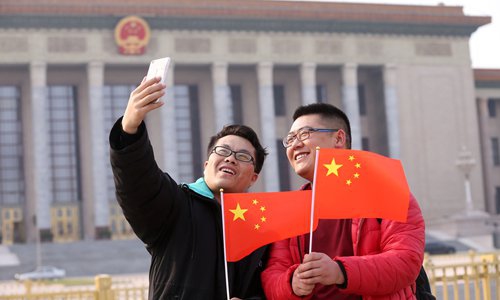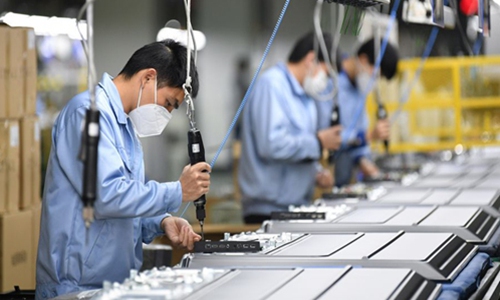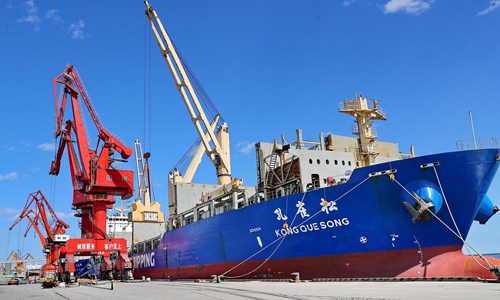Two sessions to tackle 'unprecedented' task
China won't back down on long-term goals, despite deep economic woes

Visitors pose for a selfie with Chinese national flags in front of the Great Hall of the People in Beijing. The hall is where China's "two sessions" are convened each year. Photo: IC
As more than 5,000 Chinese lawmakers and political advisors from across the country start to arrive in Beijing for the annual legislative and political consultative meetings, or the two sessions as the events are generally termed, what awaits them is a seemingly impossible task: Prescribing the right cure for the Chinese economy that was hit hard by the coronavirus epidemic in order to not only ensure economic and social stability but also reach politically important development goals.
Before their arrival in the capital, China's top leadership already set the tone for the biggest annual gathering of government officials at all levels, society leaders, business executives and others: The Chinese economy is facing "unprecedented" challenges, but the nation will not back down from the goals of the decade - eradicating absolute poverty this year and doubling income and GDP based on 2010 levels.
How to overcome those profound challenges and reach such seemingly impossible goals under the current circumstances will be on the top of the agenda for the annual sessions of the Chinese People's Political Consultative Conference (CPPCC) National Committee, the top advisory body and the National People's Congress (NPC), the country's top legislature, according to NPC deputies, CPPCC National Committee members and other economists.
The CPPCC National Committee will kick off on Thursday, followed by the NPC session on Friday. For starters, there are two major decisions, which could result in trillions of yuan in extra economic stimulus, to be approved by the NPC: raising the deficit-to-GDP ratio and issuing special government bond.
There are also many suggestions and proposals focusing on everything from lifting the virus-hit economy of Hubei Province to supporting small businesses to boosting consumption that would be discussed during the two sessions.

Staff members work at a workshop of Skyworth in Guangzhou, south China's Guangdong Province, February 10, 2020. Chinese authorities are carefully balancing efforts to control the novel coronavirus epidemic and minimize its impact on the economy as millions of people head back to work Monday after an extended holiday. Photo: Xinhua
Not backing down"The economy and people's livelihoods are often hot topics during the two sessions… but this year we will also focus on discussions on completing goals of building a moderately prosperous society in all aspects and our targeted poverty alleviation efforts," Zhu Lieyu, an NPC deputy from South China's Guangdong Province, told the Global Times on Monday.
Increasing signs from a slew of recent meetings suggest that China's top leaders remain focused on reaching goals in poverty alleviation, GDP and income growth, despite mounting complications caused by the COVID-19 epidemic, which continues to linger overseas, and suggestions that certain goals should be carried over to next year.
On Friday, a meeting chaired by President Xi Jinping focusing on the annual government work report stressed expanding various policies to ensure the "full completion of poverty alleviation targets as well as building a moderately prosperous society in all aspects," the Xinhua News Agency reported.
While the goal to eradicate absolute poverty should have no issues regarding being reached, the target; doubling the 2020 GDP based on 2010 levels is seemingly an "impossible" mission, according to Tian Yun, vice director of the Beijing Economic Operation Association. Specifically, meeting the goal would require a GDP growth of 5.6 percent this year - a very tough job to do given the current circumstances, Tian told the Global Times on Monday.
But behind the bold decision is an unmistakable level of confidence among top officials, NPC deputies and CPPCC National Committee members regarding the Chinese economy and their ability to revive it in spite of the challenges at hand and ahead.
"As long as we fully take advantage of the strengths of our system, turn it into effective development and keep our hands in the fight against the epidemic and against poverty, we can definitely reach [both goals] in time," Lian Yuming, a member of the CPPCC National Committee and head of the Global City Development Corporation Council in Beijing, told the Global Times on Monday.
That confidence also stems from China's success in beating back the coronavirus.
"Our speed and efficiency in overcoming the epidemic is second to none in the world. That is the source of our confidence in the face of temporary difficulties," said Zhu, who is also a lawyer based in Guangzhou.
Also underneath that confidence, there are encouraging signs emerging from an accelerated pace of economic recovery. In April, exports unexpectedly grew by 3.5 percent year-on-year, industrial profits also beat expectations to record a growth of 3.9 percent, a decline in consumer spending narrowed by 8.3 percentage points from March, latest data shows.

The last batch of 5,500 tons of materials has been transported from Qinhuangdao, North China's Hebei Province to the Port of Mongla in Bangladesh for construction of the Padma Bridge. The Chinese-built project is proceeding under the Belt and Road Initiative. Despite the COVID-19 outbreak, work is proceeding normally. Photo: cnsphoto
Challenges & cure
Still, many are quick to point out the profound challenges for the Chinese economy and, along with it, an almost impossible task: making up the hundreds of billions of dollars lost in the first quarter and lifting up regions and sectors that are still under serious pressure.
Despite recent improvements, main growth drivers still continue to be constrained by a series of lingering challenges, including remaining restrictions in place to stem a possible resurgence of the virus, declining export orders due to the pandemic in overseas markets and rising burdens for businesses, particularly small businesses.
Under the current climate, many analysts believe that growth in the Chinese economy would slow to 3 percent in 2020, though some say a 5 percent growth rate is still possible. Although Chinese officials have been shifting focus from pursuit of high-speed growth to quality growth and living standards, a slower GDP growth poses serious hurdles for reaching the goal of doubling GDP and, more importantly, unemployment, an issue related to social stability, experts said.
"From the big picture, the most important thing is to stabilize the fundamentals of the Chinese economy and the most pressing task is to safeguard small businesses and protect jobs," Lian said.
To that end, there are two major plans for this year's two sessions, according to NPC deputies, CPPCC National Committee members and economists. The first is discussing whether or not to raise the deficit to GDP ratio above the long-held 3 percent line that could unleash trillions of yuan in investment and other stimulus measures; the second is to discuss the issuance of a special government bond to fund more stimuli. Both of the plans would have to be approved by the NPC.
Some analysts have estimated that the deficit to GDP ratio could rise to as high as 8 percent to cope with an economic downturn, while the special government bond could raise as much as 5 trillion yuan.
Beyond these major moves, there have also been a slew of suggestions and proposals of more targeted measures for regions and businesses that have been hit hard by the COVID-19 epidemic.
To help the economy in Hubei Province, which was hit hardest by the epidemic, Zhu, the NPC deputy, has suggested exempting the province from taxation for two years for the sacrifice it made in the fight against the COVID-19.
But that goes beyond a show of appreciation; supporting Hubei's economy is also in line with China's targeted approach in reviving the economy, in stark contrast to the massive stimulus plan during the 2008-09 global financial crisis, analysts pointed out.
Under that approach, there are also a slew of other suggestions and proposals expected to emerge from the two sessions targeting specific areas, including helping private enterprises, particularly small and medium-sized companies, boosting domestic consumption, embracing new growth areas such as livestreaming and new infrastructure investments, according to analysts.
"The bottom line is that as long as we maintain a stable employment and make sure workers have a stable income, all the rest, including the two major goals, will work out eventually," Tian said.